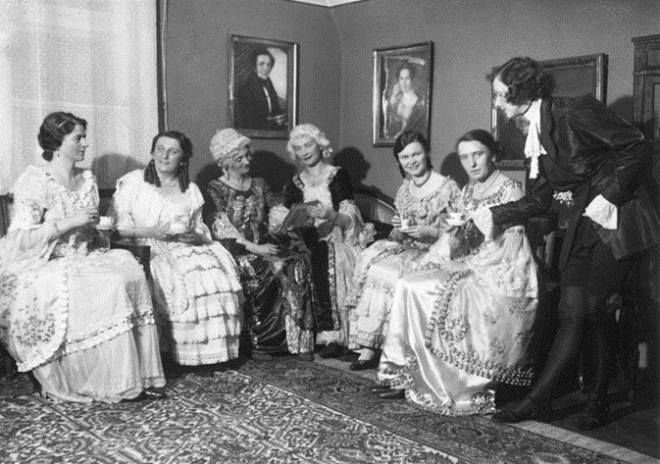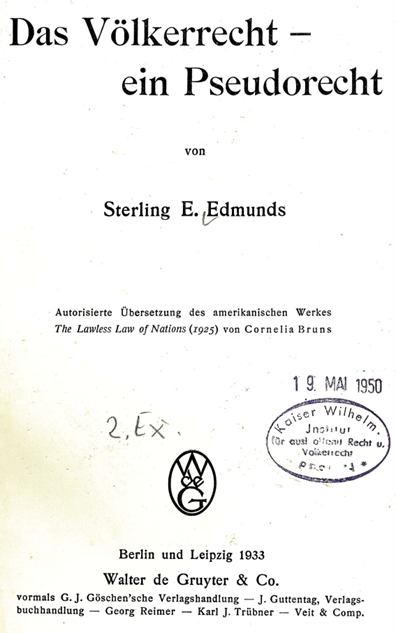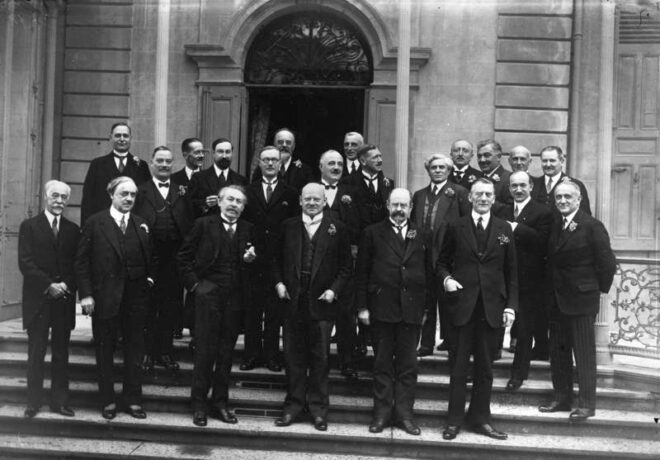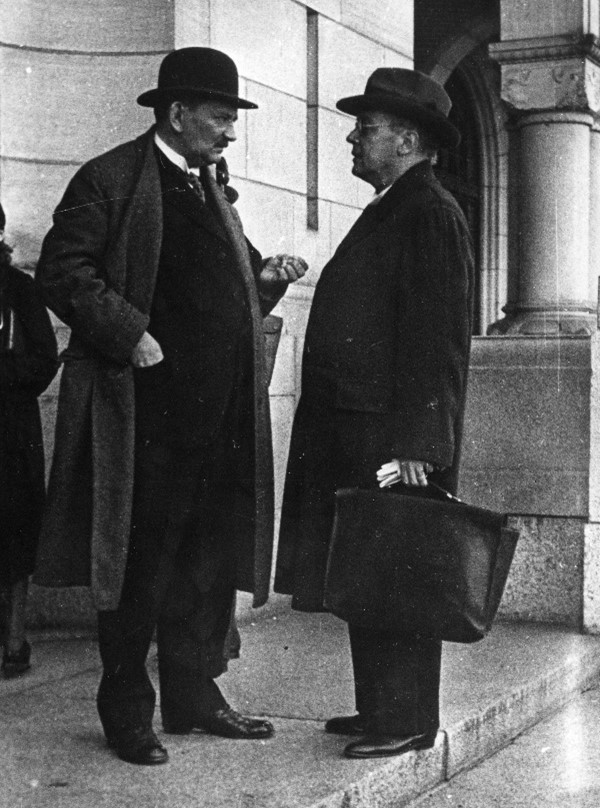Deutsch

Cornelia Bruns, Aufnahme um 1935[1]
Wenn man das 100-jährige Jubiläum des Instituts für ausländisches öffentliches Recht und Völkerrecht feiert, dann steht natürlich im Vordergrund die Entwicklung des Völkerrechts und der Rechtsvergleichung. Selten wird dabei hinterfragt, welche rein praktischen Probleme sich damals den Wissenschaftlern stellten, den Stand der Entwicklung zu erfassen. Denn das internationale Recht, wie der Begriff deutlich macht, bezieht sich auf die zwischenstaatlichen Rechtsbeziehungen und Rechtsregeln, was den Austausch zwischen Wissenschaftlern der einzelnen Staaten voraussetzt, um den Stand des Rechts und die konsensfähigen Ansätze seiner Fortentwicklung – man denke nur an das Entstehen von Gewohnheitsrecht – zu kennen.
Das klingt logisch und selbstverständlich, begegnete allerdings einer nicht zu unterschätzenden Hürde: der Sprachbarriere. Während heute Englisch/Amerikanisch als „Sprache des Völkerrechts“ beziehungsweise der Wissenschaft schlechthin bezeichnet werden kann, war das vor 100 Jahren noch völlig anders. Der Zugang zu fremdsprachiger Literatur war daher problematisch und Übersetzungen ins Deutsche gab es kaum, zumal Deutsch ohnehin als besonders schwierige Sprache galt. Hinzu kommt, dass Übersetzungen fachlicher Texte, wie eben wissenschaftlicher Ausarbeitungen zu Fragen des Völkerrechts oder rechtsvergleichender Analysen, nicht nur die umfassende Beherrschung einer fremden Sprache erfordern, sondern zudem profunde Kenntnisse in dem Sachgebiet, das zur Übersetzung ansteht. Denn Begriffe, die sprachlich auf den ersten Blick keine Übersetzungsprobleme bieten, können juristisch durchaus unterschiedliche Bedeutungen haben.
Als Beispiel mag der Begriff des „acte administratif“ im französischen Recht dienen, der die Übersetzung „Verwaltungsakt“ nahelegt. Mit dieser Übersetzung käme man aber zu großen Missverständnissen, da der „Verwaltungsakt“ im deutschen Recht ein Akt ist, der ein bestimmtes Individuum oder einen bestimmten Adressatenkreis betrifft, also eine „Einzelverfügung“ ist, während der „acte administratif“ im Französischen eine „Allgemeinverfügung“ bezeichnet. Damit wird deutlich, dass Fachübersetzungen nicht nur Sprachkenntnisse, sondern auch Fachkenntnisse erfordern. Sprachbegabte Experten hatten (und haben) jedoch wenig Interesse daran, statt eigene Publikationen zu erstellen, Arbeiten anderer Wissenschaftler zu übersetzen; bei Personen mit gründlicher Fremdsprachenkenntnis aber fehlt es meist am erforderlichen Fachwissen.
„Tante Cörnchen“. Cornelia Bruns zwischen Familie und Institut
Vor diesem Hintergrund tritt nun vor etwa 100 Jahren eine Person in Erscheinung, der uneingeschränkte Hochachtung für ihre Arbeit gebührt, die seinerzeit aber wohl nicht die entsprechende Würdigung erfahren hat: Cornelia Bruns mit ihren großartigen Übersetzungen von zwei grundlegenden völkerrechtlichen Werken. Zum einen handelt es sich um die Übersetzung des einflussreichen und klassischen Lehrbuchs des Völkerrechts Corso di diritto internazionale: Introduzione Teorie generali von Dionisio Anzilotti (1923), zum anderen um die Übertragung der völkerrechtskritischen Monographie The Lawless Law of Nations von Sterling E. Edmunds (1925).

Cornelia Bruns (um 1935)[2]
Das wirft an erster Stelle die Frage auf: Wer war Cornelia Bruns? Geboren wurde sie am 10. Februar 1888 als Mitglied der im rechtswissenschaftlichen Umfeld hoch renommierten „Bruns‑Familie“, nämlich als Enkelin von Karl-Georg Eduard Bruns, dem berühmten Rechtswissenschaftler und zeitweiligen Rektor der Berliner Universität. Dessen Bruder Victor Bruns war der Großvater von Viktor Bruns, dem Gründer des Kaiser‑Wilhelm‑Instituts für ausländisches öffentliches Recht und Völkerrecht (KWI). Cornelia Bruns, die seit frühester Jugend an einem zunehmenden Verlust ihres Hörvermögens litt, der schließlich zur völligen Gehörlosigkeit führte, legte 1907 ihr Lehrerinnen-Examen ab und hielt sich dann eine Zeitlang in England auf. Von 1925 bis 1949 lebte sie in Berlin, wo sie unter dem Direktorat von Viktor Bruns als Bibliothekarin im KWI arbeitete, einer Funktion, die sie nach dem Krieg unter Carl Bilfinger am MPIL in Heidelberg fortführte. Am 7. Mai 1965 starb sie in Heidelberg.
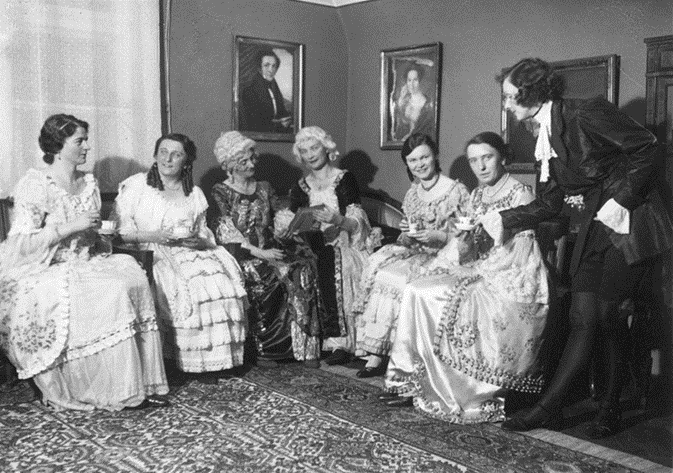
50. Geburtstag von Marie und Viktor Bruns (17.02.1935). Cornelia Bruns (dritte von links) und Mitarbeiterinnen des KWI führen bei Bruns zu Hause ein Theaterstück auf.[3]
Dies sind die wenigen Daten, die über den Lebenslauf von Cornelia Bruns bekannt sind. Weiter weiß man nur, dass sie sehr eng in die Bruns-Familie eingebunden war und von allen außerordentlich geschätzt wurde; unter ihrem Spitznamen „Tante Cörnchen“ findet sie an mehreren Stellen in den Tagebüchern von Marie Bruns-Bode, der Ehefrau von Viktor Bruns, Erwähnung, insbesondere im Zusammenhang mit Feierlichkeiten in der Familie und am KWI.[4] Über ihre beruflichen Tätigkeiten wird dort nicht gesprochen; professionelle Aktivitäten sind ein Thema, das seinerzeit überwiegend mit Bezug auf Männer zur Sprache kam, und so ist auch in den Aufzeichnungen von Marie Bruns-Bode natürlich das Wirken von Viktor Bruns als Direktor des Instituts vorrangig.
Diese wenigen über das Leben von Cornelia Bruns bekannten Daten machen jedoch zumindest ihre Fähigkeit zu Übersetzungen aus dem Englischen nachvollziehbar: Die Tatsache, dass sie sich nach 1907 „einige Zeit“ in England aufhielt, erklärt ihre gründlichen Kenntnisse der englischen Sprache und damit ihre grundsätzliche Fähigkeit, das Werk des Amerikaners Edmunds zu übersetzen. Aber woher konnte sie Italienisch? Dass sie „Fremdsprachen lesen konnte“, findet sich an manchen Stellen in den von Rainer Noltenius edierten Aufzeichnungen von Marie Bruns-Bode erwähnt. Aber um welche Sprachen es sich handelte, erfährt man dort nicht. Das Erlernen von Fremdsprachen gehörte damals zwar durchaus zur „Ausbildung“ von Töchtern gehobener Kreise, aber dass das ausreichte, ein anspruchsvolles Lehrbuch aus dem Italienischen ins Deutsche zu übersetzen, ist zumindest nicht naheliegend. Ganz offensichtlich war Cornelia Bruns dazu in der Lage, vermutlich, weil sie sich aus eigener Initiative intensiv in die Sprache eingearbeitet hatte und zudem im Arbeitsumfeld des Bruns’schen Instituts auch beachtliche völkerrechtliche Kenntnisse erlangt hatte.
Anzilotti und Edmunds. Cornelia Bruns als Übersetzerin
Von großer Bedeutung für die deutschsprachige Völkerrechtswissenschaft war insbesondere ihre im Jahre 1929 erschienene Übersetzung der dritten Auflage von Band 1: Einführung – Allgemeine Lehren des Völkerrechtslehrbuchs von Dionisio Anzilotti. Die Bedeutung, die dieser deutschen Übersetzung des klassischen Lehrbuchs zukam, findet allerdings kaum Erwähnung, und noch weniger die Übersetzerin, die auch im von Anzilotti selbst verfassten Vorwort zur deutschen Übersetzung nicht namentlich genannt wird. Nachdem Anzilotti kurz auf die neuen, in die dritte Auflage eingefügten Entwicklungen im Völkerrecht verweist, widmet er der deutschen Übersetzung einen kurzen Absatz, der hier zitiert werden soll:
„Nachdem ich dies [die allgemeine Vorbemerkung und Neuerungen der 3. Auflage] vorausgeschickt habe, bleibt mir noch die angenehme Pflicht, Herrn Prof. Dr. Viktor Bruns, Direktor des Instituts für ausländisches öffentliches Recht und Völkerrecht in Berlin, an dieser Stelle öffentlich meinen lebhaftesten Dank auszusprechen. Die große Mühe, die er sich gemacht hat, und die Art, wie er die nicht geringen Schwierigkeiten, die es zu überwinden galt, um die Übersetzung dieses Werks durchführen zu lassen, überwunden hat, verschaffen mir heute eine der größten Befriedigungen meiner wissenschaftlichen Laufbahn: der deutschen Öffentlichkeit ein Werk übergeben zu können, das der deutschen Rechtswissenschaft soviel verdankt.“ [5]
Wem Viktor Bruns die „Durchführung der Übersetzung überlassen“ hat, ergibt sich aus einer Anmerkung auf der Titelseite: „Vom Verfasser durchgesehene und autorisierte Übertragung nach der 3., erweiterten und revidierten italienischen Auflage von Cornelia Bruns u. Dr. Karl Schmid“.
Dr. Karl Schmid, besser bekannt als Carlo Schmid, war 1896 in Frankreich geboren und nahm 1919, nach seinem Dienst als Soldat im 1. Weltkrieg, sein Studium der Rechts- und Staatswissenschaften an der Universität Tübingen auf. Dort legte er 1921 das Erste Staatsexamen ab; das Zweite Staatsexamen folgte 1924. Zunächst arbeitete er als Rechtsanwalt, trat dann aber schon 1925 als Amtsrichter und später Landgerichtsrat in Tübingen in den Justizdienst ein. Von 1927 bis 1928 war er für eine Tätigkeit als Referent am Berliner KWI beurlaubt. 1929 habilitierte er sich in Tübingen mit einer Arbeit über „Die Rechtsprechung des Ständigen Internationalen Gerichtshofs“. Seine spätere Karriere als Politiker ist allgemein bekannt und bedarf an dieser Stelle keiner näheren Darstellung. Von Interesse ist hier aber seine Beteiligung an der Übersetzung des Lehrbuchs von Anzilotti, die deshalb von großer Bedeutung ist, weil er das juristische Fachwissen mitbrachte, das die sprachlichen Fähigkeiten von Cornelia Bruns ergänzte und in einem Prozess produktiven Zusammenwirkens beider an der Übersetzung beteiligter Institutsangehöriger ein Ergebnis von bemerkenswerter Qualität ermöglichte.
Dabei sollte jedoch erwähnt werden, dass Cornelia Bruns als Bibliothekarin am KWI (und zudem wohl durch Gespräche im Familienkreis) natürlich auch über einige Kenntnisse des Völkerrechts verfügte, was bei Bibliothekaren und Bibliothekarinnen auch heutzutage ein eindrucksvolles „Nebenprodukt“ ihrer Tätigkeit ist. Dennoch bleibt ihre Leistung als Übersetzerin herausragend, zumal die Übertragung von Texten aus dem Italienischen ins Deutsche, das wesentlich konziser und, wenn man so sagen darf, weniger ausschweifend ist, immer eine Herausforderung ist, vor allem weil der Stil des Autors so weit wie möglich authentisch wiedergegeben werden soll. Wenn man in das über 400 Seiten umfassende Buch hineinsieht, so zeigt sich, dass man heute wahrscheinlich einiges anders formulieren würde, aber immer wird der juristische Gehalt absolut zutreffend und verständlich zum Ausdruck gebracht, die kennzeichnenden Unterschiede juristischer Termini und Institute und die damals noch wesentlich eingeschränkteren Bereiche des Völkerrechts, seiner Grundlagen und Entwicklungen sind klar dargestellt. Es stellte in den 1920er Jahren eine bedeutende bibliographische Bereicherung dar, ein solches Werk aus der Feder eines italienischen Völkerrechtlers verfügbar und zugänglich zu haben – neben den deutschen Standardwerken wie z.B. F. von Holtzendorff, Handbuch des Völkerrechts (4 Bände, 1885-1889) , F. Stier-Somlo, Handbuch des Völkerrechts (1912), sowie H.B. Oppenheim, System des Völkerrechts (1866), J.C. Bluntschli, Das moderne Völkerrecht der zivilisierten Staaten als Rechtsbuch dargestellt (1878), A. Quaritsch, Compendium des europäischen Völkerrechts (1913), K. Strupp, Grundzüge des positiven Völkerrechts (1928). Dies insbesondere auch deshalb, weil viele Rechtswissenschaftler fraglos in der Lage waren, englische und auch französische Werke zu lesen, Italienisch hingegen nicht zu den verbreiteten Fremdsprachen gehörte. An die rein praktischen Probleme der Übersetzung eines so umfangreichen Werks, ohne die heutzutage als selbstverständlich geltenden technischen Hilfsmittel, sei hier nur erinnert. Es darf als sicher gelten, dass Cornelia Bruns keinen Mitarbeiterstab hatte, der sie bei dieser riesigen Aufgabe unterstützte.
Cornelia Bruns‘ zweite, zeitlich vor der Übersetzung von Anzilottis Lehrbuch erschienene Übersetzung ist das Werk von Sterling E. Edmunds mit dem amerikanischen Originaltitel The Lawless Law of Nations. An Exposition of the Prevailing Arbitrary International Legal System in Relation to Its Influence Upon Civil Liberty, Disclosing It as the Last Bulwark of Absolutism against the Political Emancipation of Man (1925 in Washington erschienen). Schon der Titel lässt vermuten, dass das Werk keinklassisches Lehrbuch des Völkerrechts ist. Die deutsche Übersetzung des Titels „Das Völkerrecht – ein Pseudorecht“ verdeutlicht, dass es sich um eine sehr kritische, ja insgesamt deutlich ablehnende, Abhandlung zur damaligen Lage der zwischenstaatlichen Ordnung handelt, in der insbesondere „das Völkerrecht, so wie es gemeinhin gelehrt und praktisch angewendet wird, in seinem Einfluß und seinen Wirkungen auf die menschliche Freiheit“ (Vorbemerkung des Verfassers, S. IV der deutschen Übersetzung) dargestellt werden sollte.[6]
Professor Sterling E. Edmunds, nach Stationen als Journalist und Mitarbeiter des State Department bei Erscheinen seines Buches Völkerrechtslehrer („Lecturer on the law of nations“) an der St. Louis University School of Law, machte schon in der Vorbemerkung aus seiner Ablehnung gegenüber dem damaligen Stand des Völkerrechts keinen Hehl: „In dem vorliegenden Buch glaube ich den vollkommenen Widerspruch zwischen dem herrschenden System des Völkerrechts und dem freien Fortschritt des Menschen als eines sittlichen und sozialen Wesens dargetan zu haben. Dabei mußte ich allerdings feststellen, daß das Völkerrecht überhaupt kein Zweig der Rechtswissenschaft ist; ich war infolgedessen genötigt, mich insoweit von meinen Berufsgenossen zu trennen. Ich hoffe aber und vertraue darauf, daß einige von ihnen […] mit mir einen sicheren Weg suchen werden, der weniger durch politische Raubtiere gefährdet ist, für die der Mensch bisher nichts anderes war als ein willkommener Leckerbissen“.[7]
Ob diese Bemerkungen bereits als Ausgangspunkt der menschenrechtlich fokussierten Entwicklung des Völkerrechts anzusehen sind, soll hier nicht näher vertieft werden. Bemerkenswert ist allerdings, dass die Kritik des Verfassers sich im Wesentlichen auf die kriegerischen Auseinandersetzungen richtet und dass, so schlussfolgert er, „die Herrschaft eines wahren Völkerrechts“ erst beginnen könne, wenn es auf der Basis „der Anwendung jener Grundsätze der Gerechtigkeit und des Anstands auf die Gemeinschaftsbeziehungen beruht, die vernünftige Menschen in ihren persönlichen Beziehungen anzuwenden gelernt haben – an Stelle eines Systems des Scheines, der Vorrechte, der Gewalt, das den künstlichen Ungeheuern angepaßt ist, die sich souveräne Staaten nennen“ (S. 442 der Werkes in den Schlussbemerkungen).[8]
Edmunds‘ idealistische Vorstellung einer progressiven Entwicklung der Staatengemeinschaft ist fast anrührend, bestärkt jedoch eher den Gedanken, dass das Völkerrecht gerade dazu aufgerufen ist, die Beziehungen der Staaten der „künstlichen Ungeheuer“‑ in einer Welt, die nun einmal nicht ideal ist, zu regeln. Die Übersetzung des unmittelbar nach Erscheinen intensiv rezipierten, unter anderem im American Journal of International Law von Jackson L. Ralston kritisch besprochenen Buches war nicht vom KWI „veranlasst“ worden, sondern ging auf einen Wunsch des Verfassers selbst zurück, der „durch Vermittlung des Herrn Professor Hermann Heller (jetzt an der Universität Frankfurt/Main)“ erfüllt wurde. Das ergibt sich aus der „Vorbemerkung der Übersetzerin“, die dem Buch vorangestellt ist und die zudem den Dank der Übersetzerin an die Personen zum Ausdruck bringt, die sie bei der Fertigstellung der Arbeit mit ihrem Fachwissen besonders unterstützt haben. Offiziell ist Cornelia Bruns auf der Titelseite des Werks erwähnt mit den auch in der Anzilotti-Übersetzung verwendeten Worten: Autorisierte Übersetzung des amerikanischen Werks The Lawless Law of Nations (1925) von Cornelia Bruns.
Fast ein Jahrhundert nach ihrer Fertigstellung werden diese kenntnisreichen und durch hohe sprachliche Sensibilität ausgezeichneten Arbeiten der Übersetzerin Cornelia Bruns hier erstmals gewürdigt und erinnern daran, dass die Wissenschaft, nicht nur die Rechtswissenschaft, zu ihrer Entwicklung auch heute noch nicht allein die innovativen wissenschaftlichen Fachleute und Denker braucht, sondern auch die eher „stillen Unterstützer“ im Hintergrund. Die Anerkennung für ihren Einsatz schließt dieses kurze Gedenken an Cornelia Bruns ein.
[1] VI. Abt., Rep. 1, Nr. KWIauslöffRechtuVölkerrecht III/29, AMPG.
[2] VI. Abt., Rep. 1, Nr. KWIauslöffRechtuVölkerrecht III/27, AMPG.
[3] Fotografin: Lore Feininger, Berlin: VI. Abt., Rep. 1, Nr. KWIauslöffRechtuVölkerrecht III/22, AMPG.
[4] Rainer Noltenius (Hrsg.), Mit einem Mann möcht ich nicht tauschen. Ein Zeitgemälde in Tagebüchern und Briefen der Marie Bruns-Bode (1885-1952), Berlin: Reimer 2018.
[5] Dionisio Anzilotti, Lehrbuch des Völkerrechts. Band 1: Einführung – Allgemeine Lehren, Autor. Übers. Cornelia Bruns / Dr. Karl Schmid, Berlin: De Gruyter 1929, IV.
[6] Sterling, E. Edmunds, Das Völkerrecht – ein Pseudorecht, Autor. Übers. Cornelia Bruns, Berlin: De Gruyter 1933, „Vorbemerkung des Verfassers“, IV.
[7] Sterling (Fn. 6), „Vorbemerkungen des Verfassers“, IV.
[8] Sterling (Fn. 6), „Schluss“, 442.
|
Suggested Citation: Karin Oellers-Frahm, Cornelia Bruns. Eine wohlverdiente, wenn auch späte, Würdigung, DOI: 10.17176/20240327-140753-0 |
|
| Lizenz: CC BY-NC-SA 4.0 DEED | |
English

Cornelia Bruns, photo taken around 1935[1]
When celebrating the 100th anniversary of the Institute for Comparative Public Law and International Law, the focus is of course on the development of international law and comparative law. What is rarely questioned is the purely practical problems that scholars faced at that time in capturing the state of the developments. This is because international law, as the term clearly indicates, refers to inter-state legal relations and legal rules, which presupposes an exchange between scholars from the individual states in order to know the state of the law and the consensual approaches to its further development – one need only consider the emergence of customary law.
This sounds logical and self-evident, but it presented a hurdle that should not be underestimated: the language barrier. While today English can be considered the “language of international law” or of academia per se, 100 years ago this was completely different. Access to foreign-language literature was therefore problematic and there were hardly any translations into German, especially as German was considered a particularly difficult language. In addition, translations of specialist texts, such as academic papers on questions of international law or comparative legal analyses, not only require a comprehensive command of a foreign language, but also in-depth knowledge of the subject area being translated. This is because terms that at first glance do not pose any translation problems can actually have different meanings in legal terms.
Thus, for example, the term “acte administratif” in French law, which suggests the translation “Verwaltungsakt” (administrative act), may serve as an example. However, this translation would lead to major misunderstandings, as the “Verwaltungsakt” in German law is an act that concerns a specific individual or a specific group of addressees, i.e. an “Einzelverfügung” (individual decree), whereas the “acte administratif” in French refers to an “Allgemeinverfügung” (general decree). This makes it clear that specialist translations require not only language skills, but also specialist knowledge. However, linguistically gifted experts had (and have) little interest in translating the work of other scientists rather than producing their own publications; people with a thorough knowledge of foreign languages, however, usually lack the necessary specialist knowledge.
“Tante Cörnchen”: Cornelia Bruns between family and institute
Against this backdrop, around 100 years ago, a person emerged who deserves the highest respect for her work, but who probably did not receive the appropriate recognition at the time: Cornelia Bruns, with her magnificent translation of two fundamental works of international law. The first is the translation of the influential and classic textbook on international law Corso di diritto internazionale: Introduzione-Teorie generali by Dionisio Anzilotti (1923), and the second is the translation of Sterling E. Edmunds’s controversial monograph critical of international law, The Lawless Law of Nations (1925).

Cornelia Bruns (around 1935)[2]
First and foremost, this raises the following question: who was Cornelia Bruns? Born on February 10, 1888, she was a member of the highly renowned “Bruns family” of legal scholars, namely she was the granddaughter of Karl-Georg Eduard Bruns, the famous legal scholar and temporary rector of Berlin University. His brother, Victor Bruns, was the grandfather of Viktor Bruns, the founder of the Kaiser Wilhelm Institute for Comparative Public Law and International Law. Cornelia Bruns, who suffered from an increasing loss of hearing from an early age, which eventually led to complete deafness, passed her teacher’s examination in 1907 before residing in England for some time. From 1925 to 1949 she lived in Berlin, where she worked under the directorship of Viktor Bruns as a librarian at the Kaiser Wilhelm Institute for Comparative Public Law and International Law, a position which she then continued after the war under Carl Bilfinger at the Max Planck Institute for Comparative Public Law and International Law in Heidelberg. She died in Heidelberg on May 7, 1965.

The 50th birthday of Marie and Viktor Bruns (17 February, 1935). Cornelia Bruns (third from left) and KWI employees perform a play at the Bruns’ home.[3]
These are the few details that are known about Cornelia Bruns’ life. Beyond that, we only know that she was very closely involved in the Bruns family and was held in extremely high esteem by everyone; she is mentioned in several places in the diaries of Marie Bruns-Bode, the wife of Viktor Bruns, under her nickname “Tante Cörnchen” (“Mit einem Mann möcht ich nicht tauschen” (“I wouldn’t swap places with a man”), particularly in connection with celebrations in the family and at the Kaiser Wilhelm Institute.[4] There is no mention of her professional activities; professional activities are a topic that was predominantly discussed in relation to men at the time, and so Marie Bruns-Bode’s notes naturally focus on Viktor Bruns’ work as Director of the Institute.
However, the few biographical details known about Cornelia Bruns’ life at least make her ability to translate from English comprehensible, and the fact that she spent “some time” in England after 1907 explains her thorough knowledge of English and thus her general ability to translate the work of the American Edmunds. But how did she know Italian? The fact that she “could read foreign languages” is mentioned in some places in Marie Bruns-Bode’s notes, edited by Rainer Noltenius. Yet we are not told which languages these were. Learning foreign languages was certainly part of the “education” of daughters of the upper classes at the time. But whether this was enough to translate a sophisticated textbook from Italian into German remains unclear. Cornelia Bruns was obviously in a position to do so, presumably because she had familiarized herself intensively with the language on her own initiative and was also able to develop considerable knowledge of international law in the working environment of the Bruns Institute.
Anzilotti and Edmunds. Cornelia Bruns as translator
Her translation of the third edition of Volume 1: Introduction – General Doctrines of Dionisio Anzilotti’s textbook on international law, published in 1929, was of particular importance for German-speaking scholars of international law. However, the importance of this German translation of the classic textbook is hardly mentioned, and even less so the translator, who is not even mentioned by name in the preface to the German translation written by Anzilotti himself. After Anzilotti briefly refers to the new developments in international law included in the third edition, he devotes a short paragraph to the German translation, which is quoted here:
“Having said this [the general preliminary remarks and new features of the 3rd edition], it falls to me to take this opportunity to publicly express my most sincere thanks to Prof. Dr. Viktor Bruns, Director of the Institute for Foreign Public Law and International Law in Berlin. The great effort he made and the way in which he overcame the not inconsiderable difficulties that had to be overcome in order to have this work translated today give me one of the greatest satisfactions of my academic career: to be able to hand over to the German public a work that is so greatly indebted to German jurisprudence.”[5]
Who Viktor Bruns “left the translation to” is clear from a note on the title page: “Transmission reviewed and authorized by the author after the 3rd, expanded and revised Italian edition by Cornelia Bruns u. Dr. Karl Schmid”.
Dr. Karl Schmid, better known as Carlo Schmid, was born in France in 1896 and began studying law and political science at the University of Tübingen in 1919 after serving as a soldier in the First World War. He passed his first state examination there in 1921; the second state examination followed in 1924. He initially worked as a lawyer, but then joined the judiciary in 1925 as a municipal judge and later state court judge in Tübingen. From 1927 to 1928, he was on leave of absence to work as a lecturer at the Kaiser Wilhelm Institute for Foreign Public Law and International Law in Berlin. In 1929, he habilitated in Tübingen with a thesis on “The Jurisdiction of the Permanent Court of International Justice”. His later career as a politician is commonly known and does not need to be described in detail here. Of interest here, however, is his involvement in the translation of Anzilotti’s textbook, which is of great importance because he brought with him the legal expertise that complemented Cornelia Bruns’ linguistic skills and, in a process of productive cooperation between the two members of the Institute involved in the translation, produced a result of remarkable quality.
It should be mentioned, however, that Cornelia Bruns, who worked as a librarian at the Kaiser Wilhelm Institute (and probably also through conversations within her family), naturally also had some knowledge of international law, which is an impressive “by-product” of the work as a librarian even today. Nevertheless, her achievement as a translator remains outstanding, especially given that the translation of texts from Italian into German, which is far more concise and, if one may say so, less verbose, is always a challenge, above all due to the fact that the author’s style must be reproduced as authentically as possible. If you look through the book of over 400 pages, you will see that some things would probably be formulated differently today, but the legal content is always expressed in an absolutely accurate and understandable way, and the characteristic differences in legal terms and institutions and the areas of international law, its foundations and developments, which were still much more limited at the time, are clearly portrayed. In the 1920s, it was a significant bibliographical enrichment to have such a work from the hand of an Italian scholar of international law available and accessible in a German translation – alongside the standard German works such as F. von Holtzendorff, Handbuch des Völkerrechts (4 vols., 1885-1889), F. Stier-Somlo, Handbuch des Völkerrechts (1912), H.B. Oppenheim, System des Völkerrechts (1866), J.C. Bluntschli, Das moderne Völkerrecht der zivilisierten Staaten als Rechtsbuch dargestellt (1878), A. Quaritsch, Compendium des europäischen Völkerrechts (1913), and K. Strupp, Grundzüge des positiven Völkerrechts (1928). This was especially the case as many legal scholars were able to read English and French works whereas Italian was not a common foreign language. The purely practical problems of translating such an extensive work without the technical aids that are taken for granted today are recalled here. It is safe to say that Cornelia Bruns had noor nearly no staff to support her in this enormous task.
Cornelia Bruns’ second translation, published before the translation of Anzilotti’s textbook, is the work by Sterling E. Edmunds with the original American title The Lawless Law of Nations. An Exposition of the Prevailing Arbitrary International Legal System in Relation to Its Influence Upon Civil Liberty, Disclosing It as the Last Bulwark of Absolutism against the Political Emancipation of Man (published in Washington in 1925). The title alone suggests that this is not a classic textbook on international law. The German translation of the title – “Das Völkerrecht – ein Pseudorecht” – illustrates that it is a very critical, indeed overall distinctly negative work on the state of international order at the time, in which in particular “…a work on International Law or The Law of Nations, as it is taught and practiced, in relation to its influence and effect upon human liberty”.[6]
Professor Sterling E. Edmunds, after working as a journalist and as a clerk in the State Department, was a lecturer on the law of nations at the St. Louis University School of Law when his book was published: “In this volume I feel that I have demonstrated the complete oppugnancy between the prevailing system of the Law of Nations and the free progress of man as a moral and social being. In doing so I have been compelled to deny that The Law of Nations is, in fact, a branch of jurisprudence, and thus to part company with my professional brethren in this field. However, I entertain the hope and belief that some of them … will … seek with me a safer route, less infested by political carnivora for whom up to now man has been but a feast.”[7]
Whether these remarks can already be seen as the starting point for the development of international law with its focus on human rights will not be discussed in detail here. However, it is noteworthy that the author’s criticism is essentially directed at armed conflicts and concludes that “the reign of a true Law of Nations” can only begin when it is “founded upon the application to collective relations of those fundamentals of justice and decency which reasonable men have learned to apply in their individual relations – not the fictitious and privileged system of violence adapted to those artificial monstrosities called Sovereign States”.[8]
Edmunds’ idealistic notion of a progressive development of the community of states is almost touching, but tends to reinforce the idea that international law is called upon to regulate the relations of states, the artificial beasts, in a world that is, after all, not ideal. The translation of the book, which was intensively received immediately after its publication and critically reviewed by Jackson L. Ralston in the American Journal of International Law, among others, was not “initiated” by the Kaiser Wilhelm Institute, but was the result of a request by the author himself, which was fulfilled “through the mediation of Professor Hermann Heller (now at the University of Frankfurt/Main)”. This is stated in the “Translator’s Preliminary Remarks” at the beginning of the book, which also expresses the translator’s gratitude to the people who have given her special support in completing the work with their specialist knowledge. Cornelia Bruns is officially mentioned on the title page of the work with the words also used in the Anzilotti translation: Authorized translation of the American work The Lawless Law of Nations (1925) by Cornelia Bruns.
Almost a century after their completion, these works by the translator Cornelia Bruns, which are both informative and distinguished by a high degree of linguistic sensitivity, are honored here for the first time and remind us that science, not only jurisprudence, continues today to require not only innovative scientific experts and thinkers for its development, but also the more “silent supporters” in the background. This short memorial to Cornelia Bruns for her efforts is a tribute to them.
Translation from the German original: Sarah Gebel
[1] VI. Abt., Rep. 1, Nr. KWIauslöffRechtuVölkerrecht III/29, AMPG.
[2] VI. Abt., Rep. 1, Nr. KWIauslöffRechtuVölkerrecht III/27, AMPG.
[3] Photographer: Lore Feininger, Berlin, VI. Abt., Rep. 1, No. KWIauslöffRechtuVölkerrecht III/22, AMPG.
[4] Rainer Noltenius (ed.), Mit einem Mann möcht ich nicht tauschen. Ein Zeitgemälde in Tagebüchern und Briefen der Marie Bruns-Bode (1885-1952), Berlin: Reimer 2018.
[5] Dionisio Anzilotti, Lehrbuch des Völkerrechts. Band 1: Einführung – Allgemeine Lehren, Autor. Übers. Cornelia Bruns / Dr. Karl Schmid, Berlin: De Gruyter 1929, IV.
[6] Sterling, E. Edmunds, The Lawless Law of Nations. An Exposition of the Prevailing Arbitrary International Legal System in Relation to Its Influence Upon Civil Liberty, Disclosing It as the Last Bulwark of Absolutism against the Political Emancipation of Man, Washington D.C.: J. Byrne 1925, „Prefatory Note“, V.
[7] Sterling (fn. 6), „Prefatory Note“, IV.
[8] Sterling (fn. 6), “Conclusion”, 427.
|
Suggested Citation: Karin Oellers-Frahm, Cornelia Bruns. A Well-Deserved, Albeit Belated, Tribute, DOI: 10.17176/20240327-140838-0 |
|
| Lizenz: CC BY-NC-SA 4.0 DEED | |

Karin Oellers-Frahm ist Senior Research Affiliate am MPIL, wo sie ab 1970 als wissenschaftliche Referentin mit Schwerpunkt internationale Gerichtsbarkeit und Rechtsvergleichung gearbeitet hat.
Karin Oellers-Frahm is a Senior Research Affiliate at the MPIL where she had worked from 1970 onwards as Research fellow focusing on international jurisdiction and comparative law.

